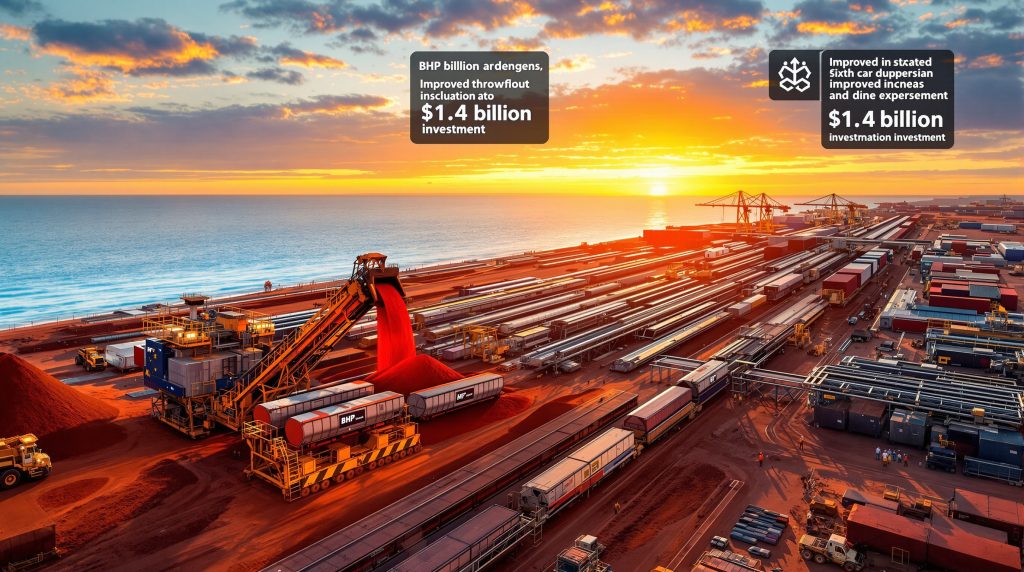BHP's $1.4 Billion Port Hedland Investment: Strategic Expansion and Economic Impact
BHP's recently approved $1.4 billion port debottlenecking project 2 (PDP2) represents a significant strategic investment in Port Hedland's infrastructure. This substantial commitment aims to enhance operational resilience and efficiency through the installation of a sixth car dumper (CD6) along with additional conveyors and supporting infrastructure. The expansion is designed to maintain Western Australia Iron Ore's (WAIO) production target of 305 million tonnes per year while significantly improving supply chain reliability.
The investment aligns with BHP's medium-term production goals and demonstrates the company's continued confidence in iron ore price trends despite fluctuating conditions. With construction set to begin in December 2025, this project represents a major commitment to the future of Australia's iron ore export capabilities.
Key Infrastructure Improvements and Operational Benefits
The centerpiece of this investment is the sixth car dumper, which will join the existing five car dumpers spread across BHP's Nelson Point and Finucane Island operations. These specialized facilities are engineered to tip two 135-tonne rail cars simultaneously, enabling up to 16,000 tonnes of Pilbara iron ore to be unloaded hourly. From there, the ore travels via 5km of conveyor systems to either stockpiles or directly to ships awaiting loading.
This technical capability represents the heart of Port Hedland's operational efficiency, where rapid unloading and transport systems are essential to maintaining Australia's iron ore leadership. The specialized car dumpers literally turn railcars upside down to empty their contents in a precisely controlled manner, representing a marvel of industrial engineering.
With the addition of CD6, BHP expects to achieve:
- Increased car dumper availability with at least five car dumpers operational more than 90% of the time (up from approximately 60% currently)
- Enhanced operational reliability and consistency across the supply chain
- Improved ore blending and screening capabilities for better product quality control
- Greater supply chain resilience across the entire operation from mine to port
These improvements will collectively strengthen BHP's ability to maintain consistent supply to international markets while reducing the impact of maintenance downtime on overall production.
What Economic Benefits Will the Port Hedland Expansion Create?
The $1.4 billion investment in Port Hedland extends far beyond operational improvements to deliver substantial economic benefits to the Port Hedland region and Western Australia more broadly. As one of the largest infrastructure investments in the region in recent years, the project will generate significant employment and business opportunities throughout its implementation phase.
The construction phase alone will create hundreds of jobs directly, with further indirect employment through supporting industries and services. This influx of economic activity will provide a welcome boost to the Pilbara region, which has experienced fluctuating fortunes tied to resource cycles.
Local Economic Impact and Indigenous Participation
During the three-year construction period scheduled to begin in December 2025, BHP has made firm commitments to prioritizing contracts for:
- Indigenous and Traditional Owner businesses, supporting economic development in local communities
- Local Port Hedland suppliers, strengthening the regional economy
- Regional Western Australian companies, extending benefits throughout the state
This approach aligns with BHP's broader commitment to supporting local communities and creating sustainable economic opportunities in regions where it operates. The company has increasingly focused on ensuring that the benefits of mining industry evolution flow to local communities and Indigenous populations, recognizing both the business value and social responsibility of such initiatives.
BHP's approach to Indigenous business inclusion has evolved significantly in recent years, with structured programs designed to build capacity and create sustainable business relationships rather than merely fulfilling compliance requirements. According to BHP's official statement, this commitment forms a cornerstone of their social license to operate in the region.
Timeline and Implementation
The project implementation follows a carefully structured timeline:
- Construction commencement: December 2025
- Expected first ore through new facilities: Q4 of FY28 (2027-28 financial year)
This strategic expansion builds upon the successful completion of the port debottlenecking project 1 (PDP1), which already delivered enhanced car dumper and ship loader performance improvements. The sequential approach to infrastructure upgrades demonstrates BHP's methodical planning process and commitment to continuous improvement at its Port Hedland operations.
The multi-year implementation timeline reflects the complexity of integrating new infrastructure into an operating port facility that must maintain production throughout the construction period. Engineers will face the challenge of connecting new systems to existing operations while minimizing disruption to the vital export flow.
Why Is Port Hedland Critical to Australia's Iron Ore Industry?
Port Hedland stands as the cornerstone of Australia's iron ore export industry and a vital contributor to the national economy. As the world's largest bulk export port, it serves as the primary gateway for Pilbara iron ore reaching international markets, particularly in Asia. The port's strategic location on Australia's northwest coast provides direct access to major Asian markets, particularly China, which remains the dominant customer for Australian iron ore.
The significance of Port Hedland extends beyond BHP's operations, as it also serves other major producers including Fortescue Metals Group and Roy Hill. Collectively, these operations make the port a critical node in global supply chains and a barometer for Australia's resource economy.
Strategic Significance of Port Hedland
The port's strategic importance is highlighted by several factors that position it as a globally significant infrastructure asset:
| Port Hedland Significance | Key Metrics and Context |
|---|---|
| Export Volume | Handles over 500 million tonnes annually across all operators |
| Economic Contribution | Iron ore exports through Port Hedland contribute approximately 3% to Australia's total GDP |
| Global Supply Chain | Critical link in global steel production supply chains, particularly for Asian steel mills |
| Regional Employment | Major employer in the Pilbara region with thousands of direct and indirect jobs |
| National Revenue | Generates billions in royalties and tax revenue for state and federal governments |
This strategic asset requires continuous investment to maintain efficiency and expand capacity as Australia competes with other major iron ore exporters, particularly Brazil, for market share in key Asian markets.
BHP's Production Performance
BHP's Western Australia Iron Ore operations have demonstrated strong performance recently, with record achievements in the last financial year:
- Record full-year production of 290 million tonnes (100% basis)
- Record shipments through Port Hedland facilities
- Continued operational improvements across the integrated mine-to-port network
These achievements underscore the importance of the Port Hedland infrastructure in BHP's overall production system and highlight why continued investment in reliability and efficiency is essential to maintaining competitiveness.
How Does This Investment Compare to BHP's Historical Port Hedland Developments?
The $1.4 billion commitment to PDP2 represents the latest chapter in BHP's long history of strategic investments in Port Hedland infrastructure. This continued development reflects the company's enduring confidence in iron ore demand insights despite cyclical fluctuations in prices and demand.
Evolution of BHP's Port Hedland Investments
BHP's approach to Port Hedland development has evolved over decades, shifting from capacity expansion to operational reliability and efficiency. Previous significant investments include:
- Early 2000s: Initial expansion of port and rail facilities to increase export capacity during the early phases of China's rapid industrialization
- 2010s: Major infrastructure developments including additional berths, shiploaders, and conveyors to accommodate growing production volumes
- Recent years: Technological upgrades and efficiency improvements across the port facilities, focusing on automation and digital technologies
The current investment in PDP2 reflects a maturation of BHP's approach, focusing on operational resilience rather than simply adding capacity. This shift acknowledges the importance of consistent, reliable supply in maintaining customer relationships and maximizing the value of existing assets.
Sustainability and Future-Focused Elements
While focusing on operational efficiency, BHP has increasingly incorporated sustainability considerations into its Port Hedland investments. Recent developments include:
- Energy efficiency improvements in materials handling systems to reduce power consumption and emissions
- Water management initiatives to minimize environmental impact in the arid Pilbara region
- Community infrastructure support to improve livability in Port Hedland for workers and families
- Exploration of renewable energy options to reduce operational carbon footprint
These sustainability elements reflect BHP's broader corporate commitment to reducing environmental impact and addressing climate change concerns while maintaining operational excellence. The company has set ambitious emissions reduction targets and sees investments in efficiency as key contributors to achieving these goals.
What Challenges Must BHP Navigate in Port Hedland Operations?
Despite the clear benefits, BHP investment in Port Hedland faces several significant challenges in its operations that this investment aims to address. These challenges span operational, environmental, and community dimensions and require careful management to ensure the long-term viability of operations.
Operational and Environmental Considerations
BHP must navigate several complex challenges at Port Hedland:
- Weather disruptions: Cyclone season in the Pilbara can impact port operations for days or weeks at a time, requiring robust contingency planning and infrastructure designed to withstand extreme weather events
- Environmental management: Dust control and water management requirements have become increasingly stringent, requiring sophisticated monitoring and mitigation systems
- Coordination complexity: Orchestrating the movement of massive ore volumes from multiple mines across hundreds of kilometers of rail network demands precise logistics management
- Maintenance requirements: Ensuring continuous operation of critical infrastructure in a harsh, corrosive coastal environment demands comprehensive preventive maintenance programs
- Community considerations: Balancing industrial operations with community needs in Port Hedland township requires ongoing engagement and investment in noise and dust mitigation
These challenges are intensified by the 24/7 nature of operations and the sheer scale of material movement through the port facilities. The port debottlenecking project directly addresses several of these challenges by building redundancy and resilience into critical infrastructure.
Market Dynamics and Competition
The investment also positions BHP to navigate changing market dynamics that create both opportunities and threats:
- Fluctuating iron ore prices and demand patterns require operational flexibility to maintain profitability
- Competition from other major producers in Australia and Brazil drives continuous improvement in efficiency and cost management
- Changing customer requirements for ore quality and consistency necessitate improved blending and quality control capabilities
- Emerging ESG expectations from investors and customers increase pressure for sustainable operations and transparent reporting
BHP's investment in port infrastructure demonstrates a long-term view that looks beyond current market conditions to build sustainable competitive advantage through operational excellence and reliability.
What Does This Investment Signal About BHP's Long-Term Strategy?
BHP's substantial investment in Port Hedland infrastructure signals several important strategic priorities that provide insight into the company's vision for its future in the iron ore business.
Strategic Positioning and Market Confidence
The $1.4 billion commitment to PDP2 reveals BHP's strategic thinking in several areas:
- Long-term commitment to iron ore: Despite market fluctuations, BHP sees iron ore as a core business for decades to come, even as the company diversifies into future-facing commodities
- Focus on operational excellence: Investing in reliability and efficiency rather than just capacity expansion demonstrates a mature approach to maximizing value from existing assets
- Supply chain resilience: Building redundancy and flexibility into critical export infrastructure helps protect against disruptions and maintains customer confidence
- Regional economic development: Contributing to the Pilbara's economic sustainability reinforces BHP's social license to operate and builds goodwill with key stakeholders
The investment also signals confidence in continued strong demand for iron ore from key markets, particularly in Asia, despite potential long-term shifts in steel production methods and increasing emphasis on recycled materials.
Integration with Broader Corporate Strategy
This investment aligns with BHP's broader corporate strategy elements:
- Portfolio optimization focusing on tier-one assets with low costs and long life expectancy
- Operational excellence and productivity improvements to maximize returns throughout market cycles
- Community engagement and social license priorities that recognize the importance of stakeholder support
- Balanced approach to shareholder returns and growth investments to ensure long-term sustainability
BHP's Western Australian Iron Ore asset president Tim Day captured the strategic significance when he noted: "The Pilbara is the engine room of the Australian economy, and this investment will ensure it keeps firing." This statement acknowledges both the economic importance of iron ore operations and BHP's role in sustaining that contribution.
How Will This Investment Impact Western Australia's Economy?
The $1.4 billion investment in Port Hedland infrastructure will generate ripple effects throughout the Western Australian economy, supporting jobs, businesses, and government revenues during both construction and operational phases.
Regional Economic Benefits
The project will generate significant economic activity beyond direct construction jobs:
- Supply chain opportunities for local businesses providing materials, equipment, and services
- Skills development and training initiatives to build local workforce capabilities
- Infrastructure improvements benefiting the broader community and other industries
- Increased economic activity in Port Hedland and surrounding areas through worker spending and business expansion
These benefits are particularly significant for the Pilbara region, which remains heavily dependent on mining activity for economic prosperity. The project's three-year construction timeline provides a substantial period of increased economic activity, helping to smooth the boom-bust cycles that have historically characterized regional mining economies.
State and National Economic Significance
At a broader level, the investment reinforces Western Australia's position as a global resources powerhouse:
- Strengthening export capacity for one of Australia's most valuable commodities, which generated over $150 billion in export earnings in recent years
- Supporting royalty and tax revenues for state and federal governments, which fund essential public services
- Maintaining Australia's competitive position in global iron ore markets against international competitors
- Contributing to national economic resilience through resource exports that help balance Australia's trade accounts
The investment also sends a positive signal to international investors about the long-term viability of Australia's resource sector, potentially encouraging further capital inflows to related industries and infrastructure.
FAQ: BHP's Port Hedland Investment
What is the primary purpose of BHP's $1.4 billion investment?
The investment aims to enhance operational resilience at Port Hedland through the installation of a sixth car dumper and supporting infrastructure, improving reliability and efficiency in BHP's iron ore export operations.
When will construction begin and when will the new facilities be operational?
Construction is scheduled to begin in December 2025, with the first ore expected to flow through the new facilities by the fourth quarter of the 2027-28 financial year.
How will this investment benefit local communities?
BHP has committed to prioritizing contracts for Indigenous and Traditional Owner businesses and local Port Hedland suppliers during the three-year construction period, creating economic opportunities for the region.
What production capacity is BHP targeting with this investment?
The investment supports BHP's medium-term plans to maintain Western Australia Iron Ore's production of 305 million tonnes per year.
How does this project relate to previous Port Hedland investments?
This project (PDP2) follows the successful completion of the port debottlenecking project 1 (PDP1), which already delivered enhanced car dumper and ship loader performance improvements.
What technical challenges exist in implementing this project?
Engineers must integrate new infrastructure into an operating port facility while minimizing disruption to ongoing export operations, managing environmental considerations, and ensuring all systems meet rigorous safety standards.
Strategic Significance of BHP's Port Hedland Investment
BHP's $1.4 billion commitment to Port Hedland represents more than just an infrastructure upgrade—it signals the company's long-term confidence in iron ore price forecast and its commitment to operational excellence in Western Australia. By enhancing the reliability and efficiency of its export operations, BHP is positioning itself to maintain its competitive edge while contributing to regional economic development.
The investment highlights the critical role that Port Hedland plays in Australia's resource economy and global supply chains. As BHP's Western Australia Iron Ore asset president Tim Day noted, "The Pilbara is the engine room of the Australian economy, and this investment will ensure it keeps firing."
With construction set to begin in December 2025, this project will not only strengthen BHP's operational capabilities but also create significant opportunities for local businesses and communities in the Pilbara region. The long-term benefits of this strategic investment will extend beyond BHP to support Western Australia's position as a global resources powerhouse for years to come.
The port debottlenecking project exemplifies how targeted infrastructure investments can deliver benefits across multiple dimensions—operational efficiency, supply chain resilience, economic development, and stakeholder relationships. In an industry often characterized by boom-and-bust cycles, such investments in operational resilience may prove more valuable than pure capacity expansion, ensuring consistent performance through varying market conditions.
Disclaimer: This article contains forward-looking statements about future operations and market conditions. Actual outcomes may differ from these projections due to various factors including market fluctuations, regulatory changes, and operational developments.
Want to Capitalise on the Next Major Mineral Discovery?
Discover how significant ASX mineral finds can generate substantial returns by exploring Discovery Alert's dedicated discoveries page, powered by the proprietary Discovery IQ model that transforms complex data into actionable investment insights. Begin your 30-day free trial today at https://discoveryalert.com.au/discoveries/ and position yourself ahead of the market.




